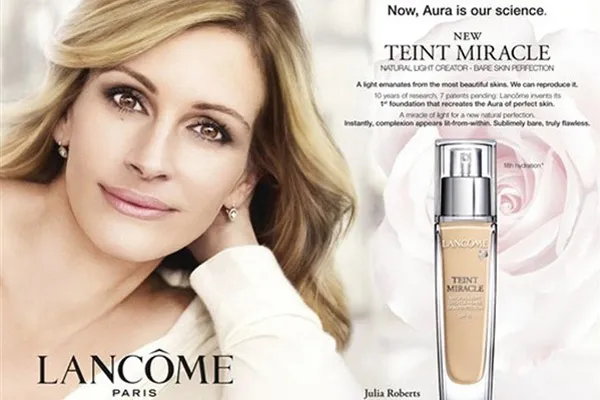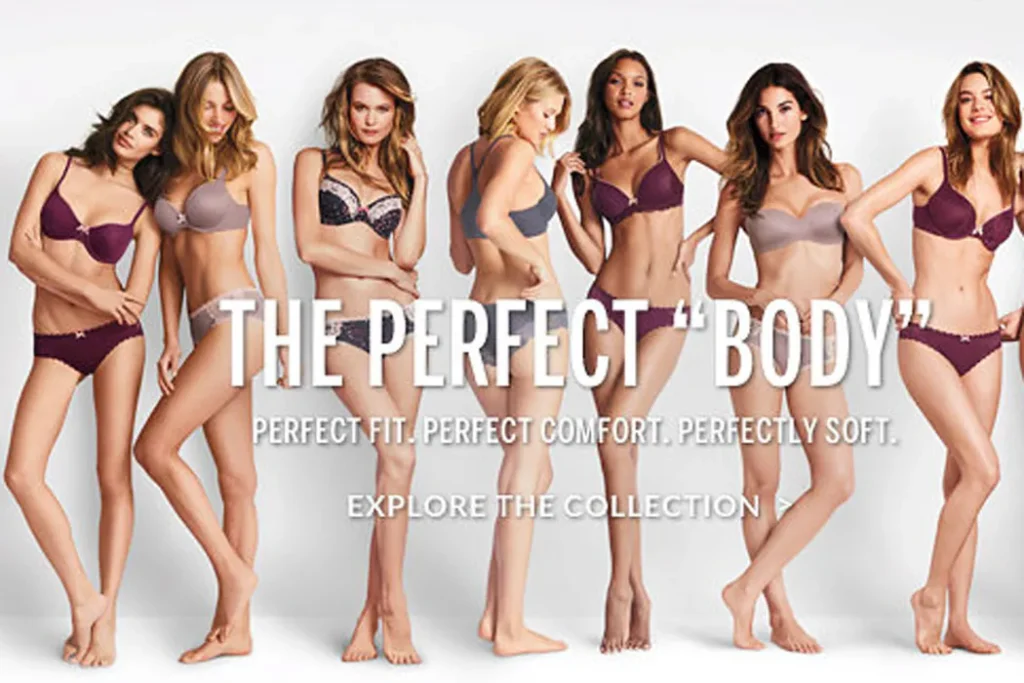Data driven digital marketing(DDM) and advertising can help perpetuate certain expectations and or standards set for themselves, especially the marketing/advertising that is considered to be part of the beauty industry that has a female target audience. The beauty standards that these advertisements make the individual who consume the media believe that if they use that specific product they will be able to look like the models in the advertisements. This shows that data driven marketing/advertising can shape the individual for the worse.

Figure 1: Image of a woman leaning next to a foundation

Figure 2: Image of multiple women modelling underwear
The main question to ask is what actually is DDM and how this even occurs in the first place. DDM can be described as a new modern method of using data analysis, such is backed by AI, big data, Customer Relationship Management(CRM) and Machine Learning(ML), to better understand what trends and individual customer preferences are to attempt to better sell a product or service(García‑y‑García, E. et al 2024). With this understanding of what DDM is, the concern about how targeted the advertising and marketing is and how this may affected the audience that was chosen as the target audience.
With this understanding of what DDM is, it can be seen that with certainty that beauty advertising and marketing is specifically targeting insecurities that come from societal beauty standards, which in turn make women more likely to buy whatever the product or service is being advertised that make beauty standard achievable for the individual purchasing whatever is being advertised, which can cause an erosion of the buyer’s decision making and causing impulse buying of these products and services(Nadler, A. and McGuigan, L. 2018). This method of marketing uses psychology as a marketing tool as well as behaviour economics to ensure the products or services will be bought and used (Nadler, A. and McGuigan, L. 2018).
Societal beauty standards that are imposed on different communities have a negative psychological on the community members about their appearance that does not match the impossible standards and in turn causing individuals effected by these beauty standards to internalizes these “standards” and then this leads to lower self-worth, self-esteem and then these individuals start to develop appearance alerting behaviour(Agrawal, A. et al 2025) to try and match these impossible beauty standards. This use of psychological marketing lead to consumer’s making biased decisions due to the manipulation used in these marketing practices(Tredinnick, L., 2023).
Beauty advertising aids the above statement about societal beauty standards due to the fact that many beauty industries, especially the make-up industry, prey on women’s insecurities to be able to better sell their products as well as attempting to set the ideal feminine beauty standards(Laham, M. 2020), which would further make their products more popular. Through DDM vulnerable individuals are more likely to believe that the usage of the product or service will help them to fit into the beauty standards that society has perpetuated(Thomas, N. and Docherty, N., 2025)
There are also some ethical concerns about privacy and psychological effects that come with the usage of DDM. Consumers have a right to privacy as well as a right to not having their data used to prey on their insecurities to get them to buy products that claim to help fix these insecurities perpetuated by society and the DDM(Laham, M. 2020). There is also the ethical concern about the usage of the collected personal data and if this data is being misinterpreted or if there are any biases that can alter the interpretation of the data in a harmful manner and then this could then lead to the harm of the target audience of the DDM(Tredinnick, L., 2023).
DDM used in the beauty industry aid in the erosion of the consumers purchase autonomy, not caring about the effects this may have on the consumer as long as this methods aids in maximizing the company’s profits(Zard, L., 2023). This uncaring approach to DDM leads to harmful advertising such as the two example adverts given. The figure one’s advert implies that if the consumer purchases that specific foundation their skin will also look like the model in the advert, even though the image of the model as been altered for her skin to appear that way, thus using beauty standards and insecurities women have about their skin to better sell their product. The second advert shows multiple models that are both beauty and have bodies that match societal standards for a beautiful body, especially for women modelling underwear. The advert implies that these are the perfect bodies and the only type of body that can purchase this product, which once again preys on women’s insecurities about their bodies which can lead them to belief that if the purchase this product they to will also have the “perfect body”. Preying on the insecurities of the consumer through DDM ultimately shapes the consumer for the worst as consumers impulsively buy these products to try and improve themselves and when that ultimately does not work, they will continue to buy more products and services shown to the via DDM, thus slowly losing their own autonomy over their spending habits as well as having a lasting negative psychological impact on them(Agrawal, A. et al 2025).
It can be seen overall that DDM shapes the targeted consumers for the worse, as this strategy of marketing does not take into consideration the negative effects this can have on the consumer psychologically, as well as, in this example of a type of DDM, perpetuating harmful and almost impossible to achieve beauty standards. The preying on consumers insecurities to maximise company profit through DDM also shows a lack of empathy and a number of ethical concerns can be raised about this marketing strategy.
Words: 943
Bibliography:
- Agrawal, A., Kondai, A. and Vemuri, K. (2025) ‘Psychological Effect of AI driven marketing tools for beauty/facial feature enhancement’. doi: 10.48550/arxiv.2504.17055.
- García‑y‑García, E., Rejón‑Guardia, F. and Sánchez‑Baltasar, L.B., (2024). A systematic literature review and research agenda of data‑driven marketing. In: Contemporary Trends in Innovative Marketing Strategies. IGI Global. Available at: https://doi.org/10.4018/979-8-3693-1231-5.ch002.
- Laham, M. (2020) Made up : how the beauty industry manipulates consumers, preys on women’s insecurities, and promotes unattainable beauty standards. Lanham: Rowman & Littlefield.
- Nadler, A. and McGuigan, L. (2018) ‘An impulse to exploit: the behavioral turn in data-driven marketing’, Critical Studies in Media Communication, 35(2), pp. 151–165. doi: 10.1080/15295036.2017.1387279.
- New Media and Marketing (no date) Advertisers Continue to Show Unrealistic Bodies in Commercials. Available at: https://www.newmediaandmarketing.com/advertisers-continue-show-unrealistic-bodies-in-commercials/
- Skarda, E. (2012). Tough Standards: 8 Ads Banned by Britain’s Advertising Authority. [online] Time. Available at: https://newsfeed.time.com/2012/02/06/tough-standards-8-misleading-ads-banned-by-u-k-standards-board/slide/julia-roberts-christy-turlington-for-loreal/.
- Thomas, N. and Docherty, N., (2025). ‘Empathy Code’: The dangers of automating empathy in business. Business & Society, [online] Available at: https://doi.org/10.1177/00076503241310142.
- Tredinnick, L., (2023). Dangerous Data: Analytics and Information Behaviour in the Commercial World. Business Information Review, 40(1). Available at: https://journals.sagepub.com/doi/full/10.1177/02663821231160964.
- Zard, L., (2023). Consumer Manipulation via Online Behavioral Advertising. arXiv. Available at: https://arxiv.org/abs/2401.00205.
